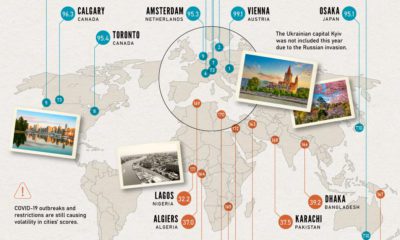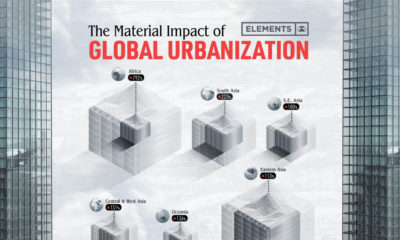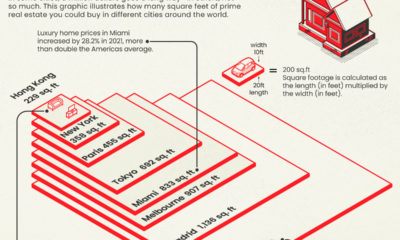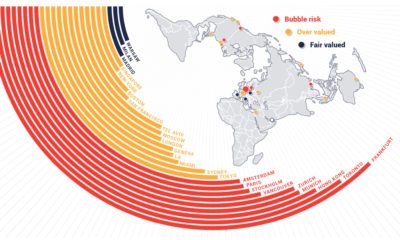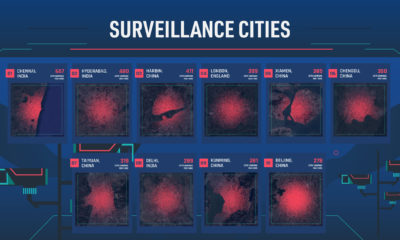While we all see the same sky, we see it a bit differently depending on where we stand. For those in the planet’s most extreme regions, the sun doesn’t follow the same pattern of seasons as it does in more temperate regions. Today’s visualization comes from Sleepopolis and summarizes the top cities on each continent that receive the most and least annual sunshine hours.
Ranked: Cities with the Least and Most Sunshine Hours
While the graphic groups the top five cities from each continent, the tables below highlight the top 10 cities from around the world that boast the highest and lowest annual sunshine hours. Top 10 Cities with the Most Annual Sunshine The sunniest city on Earth is Yuma, Arizona in the U.S. As the driest city in the U.S., Yuma receives less than 200 millimeters (8 inches) of rainfall and endures roughly 100 days of 40°C (104°F) weather every year. Yuma lies between the Gila and Colorado rivers, in a lush region that produces almost 90% of leafy vegetables grown in the U.S. Arizona boasts three of the top 10 sunniest cities in the world, including Phoenix in the fifth spot, which is the 5th most populous city in the U.S. and is known as “the Valley of the Sun”. Perhaps unsurprisingly, Egypt also has three cities in the top 10 list, with Marsa Alam, Dakhla Oasis, and Kharga claiming the 2nd, 3rd, and 9th sunniest spots, respectively. Dakhla Oasis, or “inner oasis”, receives practically zero precipitation each year. Top 10 Cities with the Least Annual Sunshine Although perceived as a sunny location, Colombia borders both the Caribbean Sea and the Pacific Ocean, exposing it to higher variety in weather patterns and precipitation. Colombia alone is home to three of the top 10 cities with the lowest hours of annual sunshine. Ranking second-to-last in the number of sunshine hours, Torshavn lies between the Scottish coast and Iceland and receives roughly 37 days of sunshine every year; the average temperatures on this island barely reach above 5°C (41°F). Our sun doesn’t shine at the same level of brightness all the time. NASA has observed that the sun goes through “solar cycles” that last roughly 11 years─brightening and dimming at relatively regular intervals and impacting how intensely we receive sunlight at any given time.
Sunshine Near the Poles
Humans typically need exposure to the sun to maintain healthy sleep habits, as our brain has been hardwired to follow natural waking and sleeping rhythms.
However, several cities experience no sun at all for several months at a time in what’s known as the “Polar Night”.
Tromsø, Norway: winter darkness is enjoyed rather than endured, as it can last for over a month Svalbard, Norway: even indirect sunlight is absent, with no change in sunlight to help indicate a 24-hour day Dikson, Russia: receives no sunlight whatsoever in December
Wherever you live, people have been watching and tracking the movements of the sun with rapt attention for millennia, even when we couldn’t see it. on Even while political regimes across these countries have changed over time, they’ve largely followed a few different types of governance. Today, every country can ultimately be classified into just nine broad forms of government systems. This map by Truman Du uses information from Wikipedia to map the government systems that rule the world today.
Countries By Type of Government
It’s important to note that this map charts government systems according to each country’s legal framework. Many countries have constitutions stating their de jure or legally recognized system of government, but their de facto or realized form of governance may be quite different. Here is a list of the stated government system of UN member states and observers as of January 2023: Let’s take a closer look at some of these systems.
Monarchies
Brought back into the spotlight after the death of Queen Elizabeth II of England in September 2022, this form of government has a single ruler. They carry titles from king and queen to sultan or emperor, and their government systems can be further divided into three modern types: constitutional, semi-constitutional, and absolute. A constitutional monarchy sees the monarch act as head of state within the parameters of a constitution, giving them little to no real power. For example, King Charles III is the head of 15 Commonwealth nations including Canada and Australia. However, each has their own head of government. On the other hand, a semi-constitutional monarchy lets the monarch or ruling royal family retain substantial political powers, as is the case in Jordan and Morocco. However, their monarchs still rule the country according to a democratic constitution and in concert with other institutions. Finally, an absolute monarchy is most like the monarchies of old, where the ruler has full power over governance, with modern examples including Saudi Arabia and Vatican City.
Republics
Unlike monarchies, the people hold the power in a republic government system, directly electing representatives to form government. Again, there are multiple types of modern republic governments: presidential, semi-presidential, and parliamentary. The presidential republic could be considered a direct progression from monarchies. This system has a strong and independent chief executive with extensive powers when it comes to domestic affairs and foreign policy. An example of this is the United States, where the President is both the head of state and the head of government. In a semi-presidential republic, the president is the head of state and has some executive powers that are independent of the legislature. However, the prime minister (or chancellor or equivalent title) is the head of government, responsible to the legislature along with the cabinet. Russia is a classic example of this type of government. The last type of republic system is parliamentary. In this system, the president is a figurehead, while the head of government holds real power and is validated by and accountable to the parliament. This type of system can be seen in Germany, Italy, and India and is akin to constitutional monarchies. It’s also important to point out that some parliamentary republic systems operate slightly differently. For example in South Africa, the president is both the head of state and government, but is elected directly by the legislature. This leaves them (and their ministries) potentially subject to parliamentary confidence.
One-Party State
Many of the systems above involve multiple political parties vying to rule and govern their respective countries. In a one-party state, also called a single-party state or single-party system, only one political party has the right to form government. All other political parties are either outlawed or only allowed limited participation in elections. In this system, a country’s head of state and head of government can be executive or ceremonial but political power is constitutionally linked to a single political movement. China is the most well-known example of this government system, with the General Secretary of the Communist Party of China ruling as the de facto leader since 1989.
Provisional
The final form of government is a provisional government formed as an interim or transitional government. In this system, an emergency governmental body is created to manage political transitions after the collapse of a government, or when a new state is formed. Often these evolve into fully constitutionalized systems, but sometimes they hold power for longer than expected. Some examples of countries that are considered provisional include Libya, Burkina Faso, and Chad.


